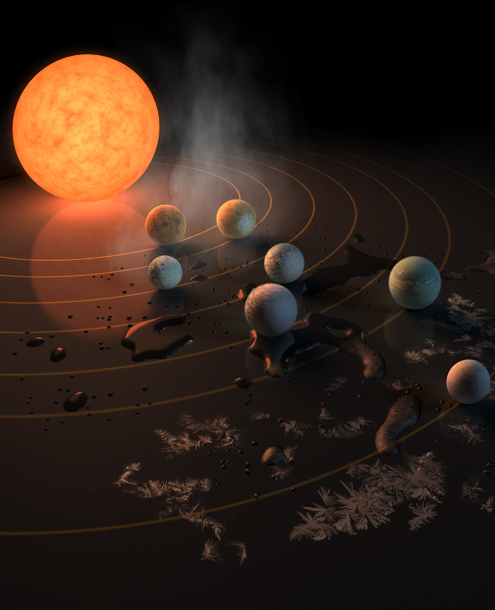Big Data on Exoplanet Composition
By Natalie Hinkel
Exploring alien worlds through the chemistry of stars
Exploring alien worlds through the chemistry of stars

The discovery of the first planets outside our Solar System, or exoplanets, in the early 1990s prompted a search for worlds that could harbor life. Habitability was initially defined simply in terms of temperature: Astronomers focused on planets that were neither too close nor too far from their stars for water to exist as a liquid on their surfaces, located in what is popularly called the “habitable zone.” But with thousands of stars and their exoplanets turned up by the Kepler Space Telescope and related searches, the definition of habitability continues to be refined. We now consider how the chemical makeup of those planets affects their suitability for supporting life.
I built and maintain a publicly available database, called the Hypatia Catalog, to help researchers explore this deeper aspect of habitability. My main goal is to study the chemistry of stars relatively near the Sun. The catalog offers a way to compare the elemental variations between different stars and to understand the relationships between stellar populations in the Milky Way. Hypatia also offers an unprecedented opportunity for exoplanetary research. Using the wealth of chemical information in the catalog, we can investigate critical questions regarding habitability.
A number of criteria in addition to liquid water and a cozy temperature are crucial to life on Earth. We must have the ingredients that make up the building blocks of living things (hydrogen, carbon, nitrogen, oxygen, phosphorus, and sulfur) along with the elements that make up the planet they inhabit (such as magnesium, aluminum, silicon, calcium, and iron). We also need active geochemical cycles to ensure that all the important elements and minerals are distributed across the world. And life on Earth requires the presence of a protective yet mostly transparent atmosphere.
Current technology cannot measure the composition of an exoplanet’s surface, let alone its interior structure. Instead, the elemental abundances in a star serve as a proxy for the elements likely found within the planets that orbit it. We can use this information in a model of a planet. This step is where the Hypatia database proves useful.
We can measure the abundances of elements in a star spectroscopically—by observing how its light interacts with the elements present within the star’s upper layers. Until now, though, these data were scattered across many different studies. I collated the chemical information collected for nearby stars in the Hypatia Catalog (www.hypatiacatalog.com), which currently lists abundances for 72 elements as observed in about 6,200 stars that are within 500 lightyears of the Sun, totaling more than 270,000 measurements (and counting!).
To create the Hypatia Catalog, I assembled spectroscopic studies—currently about 200. These studies span about 35 years of data from telescopes all over the world. The Hypatia Catalog and other large databases of stellar abundances open up a new age of exoplanet exploration.

NASA/R. Hurt/T. Pyle
My colleagues and I recently modeled water in the TRAPPIST-1 system—a family of seven planets, three of which are in the habitable zone around their red-dwarf star. We based our models on the known volumes of the planets and the likely stellar abundances of carbon, oxygen, magnesium, silicon, and iron in the host star. We found that a few of the planets, including one in the habitable zone, are likely “water worlds” composed of 5 percent to 25 percent water, which would strongly affect their habitability.
Information on potential habitability has a big impact on future planetary models, the decision about which stars to target when using high-powered telescopes, and ultimately the definition of habitability itself. All of this is possible even though, as yet, we have no direct images of the TRAPPIST-1 planets.
As the Hypatia Catalog grows, it should become an increasingly valuable scientific resource. Soon it may be possible to apply an algorithm similar to the one Netflix uses to predict which movies you may enjoy based on your past taste—but instead it will predict which stars are likely to host an undetected planet, perhaps even a habitable one.
Click "American Scientist" to access home page
American Scientist Comments and Discussion
To discuss our articles or comment on them, please share them and tag American Scientist on social media platforms. Here are links to our profiles on Twitter, Facebook, and LinkedIn.
If we re-share your post, we will moderate comments/discussion following our comments policy.